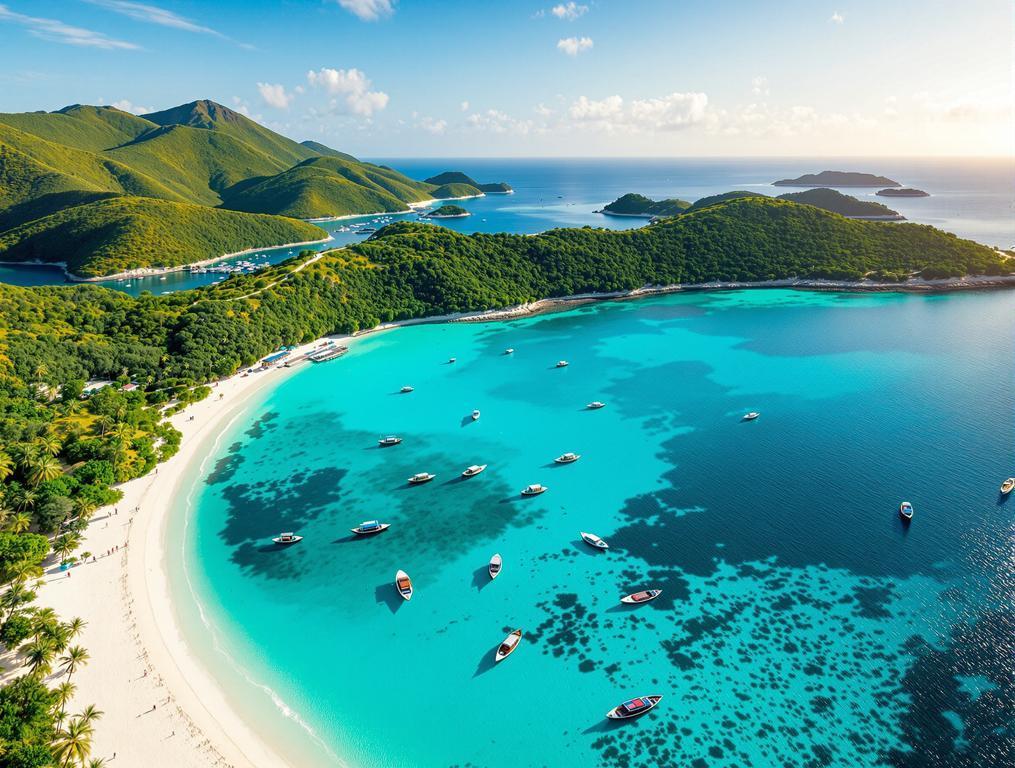The fishing boats drift lazily in Selong Belanak’s perfect horseshoe bay as I step onto sand so blindingly white it could be mistaken for Caribbean powder. I’ve just traveled 55 kilometers southwest of Lombok International Airport to reach what might be Indonesia’s most favorable beach ratio – fewer than 100 residents sharing a 2-kilometer stretch of immaculate shoreline with perhaps a dozen morning visitors. Standing here in June 2025, I’m witnessing the beginning of the perfect 90-day window when consistent offshore breezes create ideal beginner surf conditions.
Lombok’s 90-Day Perfect Window: June-August 2025
Selong Belanak sits at the heart of Indonesia’s seasonal sweet spot. The dry season from May to September delivers reliably sunny days with minimal rainfall, but June through August offers the perfect combination of gentle waves, clear visibility, and comfortable temperatures hovering around 28°C (82°F).
“Each morning feels like discovering a secret that somehow the rest of the world hasn’t caught onto yet,” a visiting Australian surfer tells me as she waxes her board. “I’ve been coming to Indonesia for fifteen years and nothing compares to this.”
What makes this window so precious is its ephemerality. By September, winds shift and swells grow larger, making conditions less ideal for beginners. And if travel patterns continue as predicted, next year’s perfect window may include significantly more visitors.
My local surf instructor points toward Warung Budi, one of approximately 15 surf schools dotting the beach. “Three years ago, we had maybe five lessons per day. Now we sometimes have twenty groups during high season,” he explains while demonstrating proper board positioning.
Like Ishigaki: Japan’s Hidden Beach Paradise, Selong Belanak offers a rare combination of accessibility and tranquility that’s becoming increasingly difficult to find in Southeast Asia.
The 100:1 Beach-to-Visitor Ratio Bali Can’t Match
The numbers tell a compelling story. While Bali’s Kuta Beach packs thousands of tourists into similar stretches of sand, creating what amounts to a 1:100 space-to-visitor ratio, Selong Belanak flips the equation. Here, each visitor enjoys approximately 100 times more beach space than at Kuta.
This mathematical reality translates into tangible experiences: unobstructed photos, easy parking, no reservation requirements at beachfront warungs, and instructors who can provide personalized attention rather than mass lessons.
“I came from Kuta yesterday where I couldn’t find space to lay my towel. Here, I have an entire section of beach to myself. It feels like stepping back in time to what Bali must have been decades ago.”
The comparison to Santo Antão: Africa’s Uncrowded Paradise is apt – both destinations offer authentic experiences without the Instagram crowds that have transformed other once-peaceful locations.
The road to Selong Belanak was paved only seven years ago, which partially explains its preserved character. Previously, reaching this crescent-shaped haven required navigating difficult dirt tracks, effectively keeping mass tourism at bay.
Why Travel Experts Compare It to “Phuket 30 Years Ago”
South China Morning Post recently described Selong Belanak as “Phuket before mass development” – a comparison that resonates as I watch fishermen mend nets beside simple bamboo-constructed warungs.
What makes the parallel to Tenerife: Europe’s Hidden Hawaii particularly apt is how both destinations balance natural beauty with accessibility. Like Tenerife’s volcanic landscapes, Selong Belanak’s dramatic backdrop of emerald hills creates breathtaking contrasts with turquoise waters.
Travel + Leisure Asia’s 2025 coverage highlighted Lombok’s infrastructure improvements, including newly launched ferry services from Bali and expanded flight options at Lombok International Airport. Yet despite these changes, Selong Belanak maintains its cultural integrity.
Integrating Authentic Sasak Culture Into Your Visit
Beyond surfing, the surrounding villages offer windows into Sasak cultural traditions that have largely disappeared from Bali’s tourist centers. In nearby Sukarara village, weavers create intricate textiles using techniques unchanged for centuries.
Local guides greet visitors with “Kemalaya” (peace) – often accompanied by a ceremonial offering of leaf-wrapped coconut water that symbolizes purity and hospitality in Sasak tradition.
Like Koh Yao Yai’s Authentic Thai Experience, Selong Belanak demonstrates how tourism and tradition can coexist when development respects local values.
Later, as Sarah photographs the sunset from Merese Hill (a 10-minute drive away), I reflect on how precious these moments of discovery feel. The Sasak have a saying – “Endak lupak asal” – never forget your origins. As travelers, perhaps our responsibility is to remember the original character of places like Selong Belanak, even as they inevitably evolve with each passing season’s perfect window.
